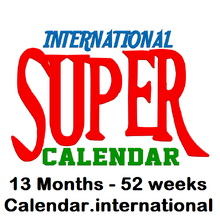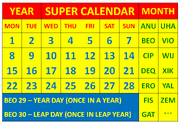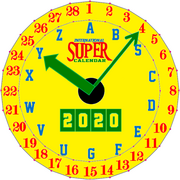
The international Super Calendar is supposed to become the Standard Unique Perennial Economical Revolutionary Calendar. It is also called Permanent International Calendar, or PINC for short. In this calendar, all days in a year are grouped into 13 months or 52 weeks. The second month is one day longer (29) than the rest (28) in normal years and the leap day is also added to its end, as in the Julian and Gregorian calendars, making this month 30 days long.
Calendar Structure[]
This calendar is a modification of the International Fixed Calendar (IFC). Both have 13 months of 4 weeks (i.e. 28 days) each. In the IFC, the excessive blank days do not belong to any month or week. The IFC has two disadvantages:
- Blank days do not belong to any month, week and weekday.
- Leap Day occurs at the end of the sixth months. So some days (about 4 months) of the Gregorian calendar have different IFC dates in leap years than in other years.
The Super Calendar has been proposed to rectify these disadvantages. The odd days are added at the end of the second month to synchronize the existing Gregorian calendar with the new calendar. Only two days in February (Feb 27 and 28) have different super calendar dates in leap years than in other years.
The Super Calendar year is divided into 13 months. All months except the 2nd month have 28 days or exactly 4 weeks. The second month has 29 days in a normal year and 30 days in a leap year.
The calendar has triple-letter alphabetical month names, since 26 letters fit nicely with 13 months. The first half of the alphabet is used for the first letter of the month names and the second half is used for the last, or sometimes the middle letter. The calendar structure with corresponding start dates in the Gregorian calendar are given in the table below.
| si no | Month name | Starting day in normal year | Total days |
|---|---|---|---|
| 01 | Anu | Jan 01 | 28 |
| 02 | Beo | Jan 29 | 29/30* |
| 03 | Cip | Feb 27/28* | 28 |
| 04 | Deq | Mar 27 | 28 |
| 05 | Ero | Apr 24 | 28 |
| 06 | Fis | May 22 | 28 |
| 07 | Gat | Jun 19 | 28 |
| 08 | Hup | Jul 17 | 28 |
| 09 | Ivo | Aug 14 | 28 |
| 10 | Jaw | Sep 11 | 28 |
| 11 | Kix | Oct 09 | 28 |
| 12 | Lay | Nov 06 | 28 |
| 13 | Mez | Dec 04 | 28 |
| sum | 365/366* |
Week[]
The calendar has 52 weeks plus the two additional odd days. It follows the standard 7-day week cycle, although there is no astronomical background of fixed 7 day cycle. The week already is the approximation of a quarter of a month and the people already accept the oddities of leap years regarding February, but they are used to neither a leap week nor a special leap weekday.
The Super Calendar brings with it a new week concept. All months except the second month have 4 weeks exactly. The second month has 4 weeks plus additional days. These additional days are known as Superdays. These days are added at the end of the last week of the second month which is called Superweek.
- Year Day
- 29th day of second month in all years.
- Leap Day
- 30th day of second month in leap years.
Therefore, the regular week cycle is interrupted once every year. The superdays are designated as holidays for everyone. Unlike in the original IFC, every year, month and week starts on Monday and normally ends with Sunday. If they started on Sunday, the number of traditional public holidays in several countries would be reduced because of New Year Day and Christmas always falling on Sundays.
The Super Calendar counts the normal year and leap years as the years. So we count the normal 7 day weeks and super week as the weeks. A year consists of 52 entire weeks like 13 entire months. A month consists of 4 weeks.
Perennial Calendar[]

The Super Calendar is a perennial calendar, because it does not change with month and year. The dates and weekdays are perfectly synchronized in this calendar. So this calendar is prepared as a single table. This calendar is the standard structure as time.
As shown in the figure, it just changes year and month. The table shows all months.
Identification of Week and Weekday[]
- Current Week = 4*Month - 3 + integer ( (Date-1) / 7 )
- Weekday Index = remainder ( Date / 7 )
- Index: 0 = Sunday, 1 = Monday, 2 = Tuesday, 3 = Wednesday, 4 = Thursday, 5 = Friday, 6 = Saturday
- If D=29, Weekday = Yearday
- If D=30, Weekday = Leapday
New weekdays proposed:
- Uranday (Uranusday): Weekday for the Year Day
- Nepday (Neptune Day): Weekday for the Leapday
Superclock[]

Super Calendar dates can be represented by an altered analog clock face. If one imagines the superdays as an imaginary month, then the calendar has 14 months. These month divisions are enough to place in a 28-division clock. Each division represents one of the 28 days. The days are shown by the long hand and months by the short hand.
- If the month position is S and the date position is 1 it denotes Beo 29.
- If the month position is S and the date position is 2 it denotes Beo 30.
- Month hand moves ahead one month division (Two day division) for one complete revolution of day hand.
- If month division moves from z to A, the year counted by 1.
- Superclock is to be corrected at the start of third month.
Varying Days[]
- February 27 = Cip 1 (Normal Year) / Beo 30 (Leap Year)
- February 28 = Cip 2 (Normal Year) / Cip 1 (Leap Year).
- February 29 = Cip 2 (Leap Year)
Other dates are perfectly synchronized.
Date Format[]
This calendar uses an alphanumeric date format: 4-digit year + alphabetic month + numeric day. The first 7 months are denoted by the first 7 letters of the alphabet (capital letter A-G). The final 6 months are denoted by the final 6 letters of the alphabet (U-Z). Traditional numeric date formats require 10 characters (e.g. CCYY:MM:DD), while the Super Calendar format requires only 7 characters.
- Format: YYYYMDD
- Example: 2020D20 denotes the 20th day in the 4th month (Deq) of year 2020.
Week Format[]
The Super Calendar uses an alphanumeric week date format: 4-digit year + numeric week + alphabetical day.
- Format: YYYYWWD
- with D one of
- a = Monday
- b = Tuesday
- c = Wednesday
- d = Thursday
- e = Friday
- g = Saturday
- h = Sunday
- y = Yearday
- z = Leapday
- Example: 202020d denotes the 20th Thursday in the year 2020.
Advantages[]
- This calendar is perpetual and perennial.
- The new weekdays Beo 29 and 30 may be assigned as holidays (Superdays).
- A single calendar is enough for all years and months.
- Weekday-based movable fests are now fixed such as second Sunday in May or third Thursday in August.
- Easter date comes in the following dates: Mar 26, Apr 2, Apr 9, Apr 16 and Apr 23. We can fix the final date Apr 21 as Good Friday, Apr 22 as Holy Saturday and Apr 23 as Easter.
- The planets Uranus and Neptune are honored by weekdays.
- Finding weekdays from month dates is very easy.
- Now we celebrate leap-day birthdays on Feb 29 as per Gregorian calendar and Feb 28 as per Supercalendar.
- Only two days vary between leap years and other years.
- Every year is exactly 13 months and 52 weeks. Each month corresponds to exactly 4 weeks.
- The calendar best suits business accounts for unique months. Superdays are considered as bonus days.
Disadvantages[]
- The year is often divided into 4 quarters of 13 weeks or 3 months each. Neither of these quarters align with the months of a 13-month year calendar. Alternatively, a quarter is exactly 3 months, i.e. usually 84 days, but this does not align with the year anymore.